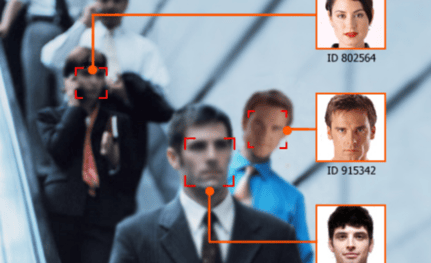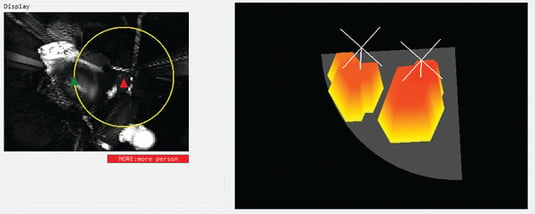With the evolving dynamics of cloud storage and the ability to harness and proactively employ an ever-increasing pool of big data, artificial intelligence (AI) has significantly impacted video surveillance, which has been among the biggest beneficiaries of faster processing and impactful analytics. Even building automation, fire systems, intrusion detection, and physical and network access control have AI built into many core competencies.
It seems clear that AI has the potential to play an increasing role in making exterior and interior entrances more secure in the fairly near term. But while AI will be able to help in many security-related tasks, such as discerning people from objects at a facility’s perimeter and interior entrances, detecting attempted piggybacking, spotting and analyzing potentially lethal objects and dangerous people, and more, AI does have its limits... it cannot take action to prevent unauthorized human entry or deny the entry of dangerous objects.
Connecting Entry Manufacturer Goals with End User Needs
Consultant Ben Butchko, President and CEO of Butchko, Inc. and a former security engineer with ExxonMobil, warns that manufacturers’ goals must align with their end users’ needs when it comes to driving the development of embedded solutions with advanced sensors (cameras, microwave, LIDAR), operational analytics (facial recognition, tracking, pattern recognition), and active response (entry lockout, alert notification) that now prevent or deter risks detected at the entry.
 “To this point, the security entrance must be part of the general building operations design, clearly separated from an architect’s complete authority. Most secured entries are specified in CSI Division 28, outside of building design since it is structural and falls under code compliance surrounding emergency egress as well as building capacity and throughput. Therefore, if this is to work, the rules for design and the merging of Division 28 and Divisions 8 and 11 must become refined, practical, and widely accepted,” says Butchko.
“To this point, the security entrance must be part of the general building operations design, clearly separated from an architect’s complete authority. Most secured entries are specified in CSI Division 28, outside of building design since it is structural and falls under code compliance surrounding emergency egress as well as building capacity and throughput. Therefore, if this is to work, the rules for design and the merging of Division 28 and Divisions 8 and 11 must become refined, practical, and widely accepted,” says Butchko.
Using Third-Party Solution Providers to Achieve Security Entrance + AI Integration
 Because many security entrances do not have AI built into their technology, integrating intelligence into secured entrances requires a collaborative effort with a third-party solutions provider. Video analytics are increasingly deployed to address use cases such as people detection, piggybacking, dangerous object detection and facial recognition among other issues relevant to secured entrances. The increased integration of AI providers with traditional security entrance partners has resulted in improvements in:
Because many security entrances do not have AI built into their technology, integrating intelligence into secured entrances requires a collaborative effort with a third-party solutions provider. Video analytics are increasingly deployed to address use cases such as people detection, piggybacking, dangerous object detection and facial recognition among other issues relevant to secured entrances. The increased integration of AI providers with traditional security entrance partners has resulted in improvements in:
- Price
- Speed
- Ease of use and usability
- The use of machine learning to improve algorithms over traditional modeling and correlation approaches
- Integration with other systems and sensors
AI Works to Replace Human Efforts at the Entry
So, what can AI do alone at a secured entrance? Basically, it can replace human effort at tasks that would be tough for people to do reliably: learn behaviors of staff, employees, and contractors; and identify people and monitor them more consistently than operators.
Currently, security entrances detect tailgaters by using near-infrared sensors – if it appears that two separate objects are breaking through the sensor beams, an alarm is generated. In security revolving doors and mantrap portals, near-infrared, “time of flight” technology is paired with optics to create a 3D image of the objects inside the door; algorithms and sampling data are used to determine whether there is one person or two. When these technologies reject a user “for no reason” (for example a person enters a door with a box of pizza and wears a backpack), that’s known as a “false rejection.”
 Advanced AI can fill the gap by recognizing people (through learned movement patterns and spacing of features) and objects the way humans can, which can bring the false rejection rate to near zero. For example, it could know the difference between any inanimate objects being worn or carried through the entrance vs. living users. It can know intimately the identity of authorized users, regardless of clothing, current weight, hair color or facial hair, and the process of aging.
Advanced AI can fill the gap by recognizing people (through learned movement patterns and spacing of features) and objects the way humans can, which can bring the false rejection rate to near zero. For example, it could know the difference between any inanimate objects being worn or carried through the entrance vs. living users. It can know intimately the identity of authorized users, regardless of clothing, current weight, hair color or facial hair, and the process of aging.
AI is a Double-Edged Sword
Butchko says the use of machine learning as well as deep learning has been used for many years in the “Big Data” world to identify trends and produce metrics regarding human intent. “Within the security industry we see a trend by companies to leverage these specific engines to gain greater benefits from access control, VMS, intrusion detection, and tracking systems. Machine learning can be seen as a double-edged sword, because tracking learned behavior can help define potential vulnerabilities and unmask potential threats, yet it can also lead to privacy and discrimination concerns, especially when intent and analytic detail are not clear.”
The Future of AI and Security Entrances
AI in the form of machine learning and deep learning has become a disruptive technological force in the physical security industry. The current stresses to security technology and security policy to meet new COVID-19 safety mandates will expedite how AI is integrated into future security entrance solutions. The push for touchless and frictionless access options and the increase in contact tracing protocols at many organizations will expand the integration of secure entrances with building control systems to help provide additional insight to potential threats and help mitigate them.

